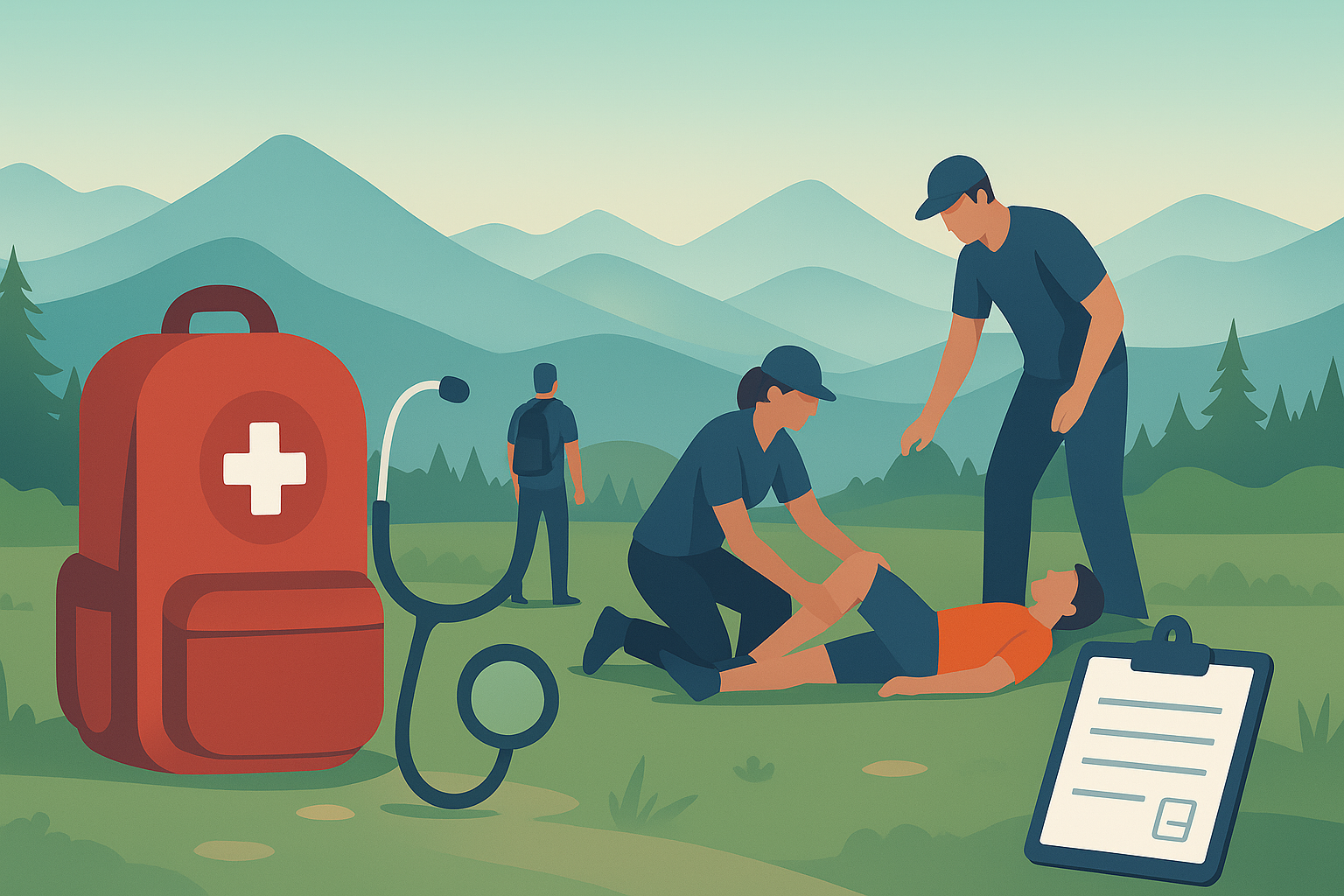How Medical Training Providers Can Offer CPD/CME Certificates for Adventure & Wilderness Medicine Courses

Adventure and wilderness medicine courses are growing in popularity — from expedition medicine workshops to remote trauma skills training. Clinicians and students are eager to gain hands-on experience in austere environments, but they also want the training to count toward their continuing professional development (CPD), continuing medical education (CME), or continuing education units (CEU).
If you run these kinds of courses, offering CPD/CME certificates can make your training more attractive, more credible, and easier to justify as a professional expense. Here’s a step-by-step guide to getting accredited, tracking attendance, and issuing certificates — without drowning in admin work.
Why CPD/CME Matters for Adventure & Wilderness Medicine
For doctors, nurses, paramedics, and other health professionals, CPD/CME requirements are not optional — they’re mandatory for maintaining registration and staying compliant with regulators. When you can offer accredited certificates:
- You make your course more appealing to participants who need to log hours.
- You help professionals stay audit-ready with proper documentation.
- You differentiate your training from casual workshops that don’t provide proof of learning.
A well-designed certificate can also double as a marketing asset — participants proudly share them on LinkedIn and include them in portfolios, giving your course organic exposure.
Step 1: Get Your Course Accredited
Before issuing CPD/CME certificates, securing accreditation from the relevant professional body is essential.
How to do it:
-
Identify the Right Accreditor
-
Australia:
- RACGP (Royal Australian College of General Practitioners): Becoming an RACGP CPD Provider
- ACRRM (Australian College of Rural and Remote Medicine): CPD Home
- ACEM (Australasian College for Emergency Medicine): CPD Program
-
Global:
- ACCME (Accreditation Council for Continuing Medical Education - USA): Accreditation Process
- EACCME (European Accreditation Council for Continuing Medical Education): Apply for Accreditation
-
-
Prepare Your Documentation
Submit the following to the accrediting body:
- Course outline
- Learning objectives
- Assessment methods
- Total hours of instruction
-
Ensure Alignment with CPD Frameworks
Accrediting bodies often require evidence of reflection or assessment to award credit. For instance:
- ACEM requires an Annual Professional Development Plan (PDP) to be completed in the MY ACEM portal. ACEM PDP
- EACCME evaluates the planning, content, educational methods, and strategies to avoid bias based on the submitted application form. EACCME Criteria
This step requires careful planning, but once completed, you can market your course as an officially recognized CPD/CME activity, instantly boosting its perceived value.
Step 2: Track Attendance Accurately
Regulators and accrediting bodies expect reliable attendance records. This can be tricky if your course takes place outdoors or in remote locations — but with the right tools, it’s manageable.
Practical Tips & Tools
-
Use Digital Sign-In Forms
-
For classroom portions or indoor sessions, use tools like:
- Google Forms: Quick, easy, free — capture name, email, and check-in time.
- Typeform: Sleek interface, mobile-friendly.
- QR Code Check-In: Print a QR code that participants scan to sign in. Free QR tools like QR Code Monkey work well.
-
Tip: Automatically timestamp submissions so you know who attended and when.
-
-
Offline Attendance for Remote or Outdoor Sessions
-
Use a simple Excel/Google Sheet template:
Participant Name Arrival Time Departure Time Signature -
After the session, upload the sheet to a digital format for certificate generation.
-
-
Track Partial Attendance
-
Record exact participation times; some accrediting bodies give pro-rated CPD/CME hours for partial attendance.
-
Example workflow:
- Morning session: 9:00–12:00
- Afternoon session: 13:00–16:00
- Log each participant’s actual attendance in each session.
-
-
Sync Attendance with Certificates
-
Platforms like CertFusion allow you to link attendance data directly to certificate issuance:
- Import digital form responses or spreadsheets.
- Auto-issue certificates only to participants who meet minimum attendance criteria.
-
-
Optional: Mobile Apps for Field-Based Tracking
-
For expedition courses, consider offline-capable apps:
- Eventee, Attendify, or Whova
- Capture attendance on tablets or phones, sync later when internet is available.
-
Accurate attendance tracking isn’t just a regulatory requirement — it ensures participants receive proper CPD/CME credit and that your certificates reflect real learning. By combining digital tools, offline templates, and automated certificate systems, you make the process smooth and professional.
Step 3: Issue Certificates the Smart Way
Manually designing, editing, and emailing certificates is slow and error-prone — especially if you’re juggling spreadsheets after a multi-day training course.
This is where automation saves hours of work.
With CertFusion, you can:
- Upload your attendance list and bulk-generate personalized certificates.
- Use professional templates that include your logo, CPD hours, and accreditor information.
- Deliver certificates instantly by email — no more back-and-forth with participants.
- Store certificates securely so participants can re-download them anytime.
This not only streamlines admin work but also creates a polished, professional experience for attendees.
Manual Process vs. Automated with CertFusion
| Task | Manual Process | With CertFusion |
|---|---|---|
| Design Certificates | Create one-by-one in Word/Canva, edit names manually | Auto-generate certificates in bulk with templates |
| Send Certificates | Attach to emails, send individually | Bulk-send to all participants instantly |
| Track Attendance | Use spreadsheets, update manually | Sync from forms, QR codes, or Zoom attendance |
| Re-Issue Certificates | Search inboxes or recreate lost files | Participants can re-download from a secure link |
| Audit Readiness | Dig through files and emails | Export all records with one click |
Step 4: Maintain Records for Compliance
Most accrediting bodies recommend keeping attendance logs and certificates for 3–5 years in case of an audit.
A digital certificate platform like CertFusion keeps everything in one place, so you can quickly export records if needed — no digging through folders or inboxes.
Step 5: Market Your Accredited Course
Once you’re accredited and issuing certificates, let people know!
- Include “CPD/CME Accredited” in your marketing materials.
- Mention the number of hours/points participants will earn.
- Showcase a sample certificate in your promotional emails or on your website.
Participants are far more likely to choose your course when they see it contributes to their professional development requirements.
Final Thoughts
Adventure and wilderness medicine training offers unique learning opportunities — but participants increasingly expect those hours to count toward their CPD or CME requirements. By securing accreditation, tracking attendance carefully, and automating certificate delivery, you can offer a premium, professional experience without adding extra admin burden.
Ready to simplify your CPD/CME certificate process?
👉 Try CertFusion’s CPD/CME/CEU Certificate Generator — create, send, and track professional certificates in minutes.
Table of Contents
Related Articles
Discover more insights and stories that might interest you
